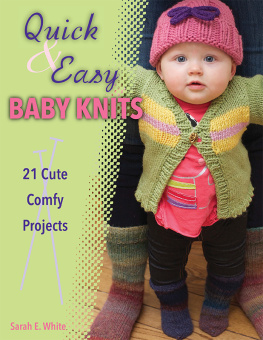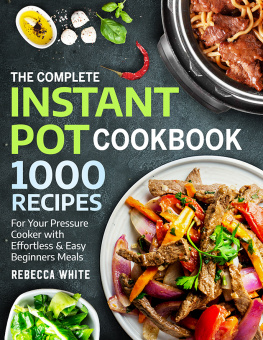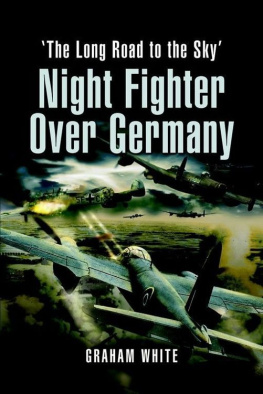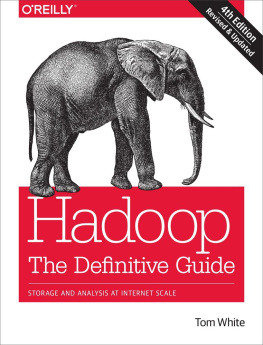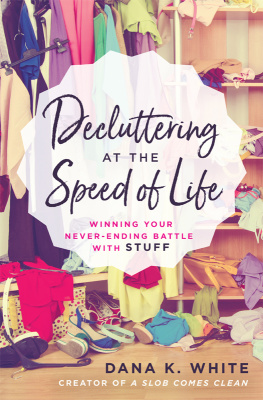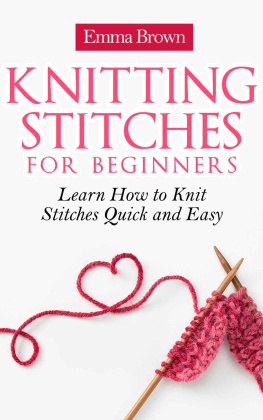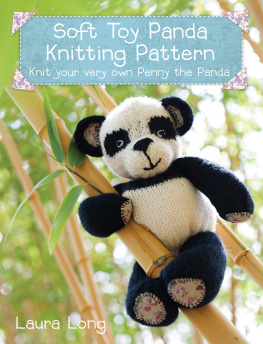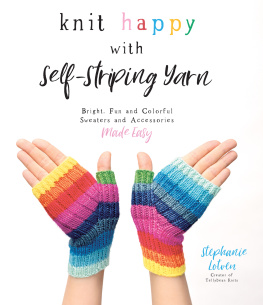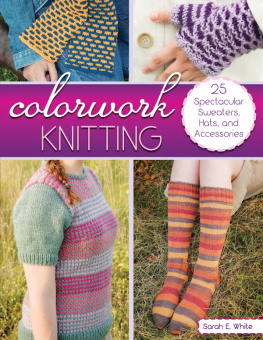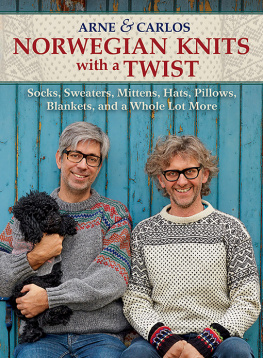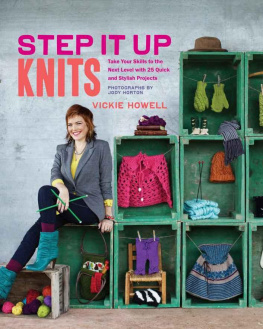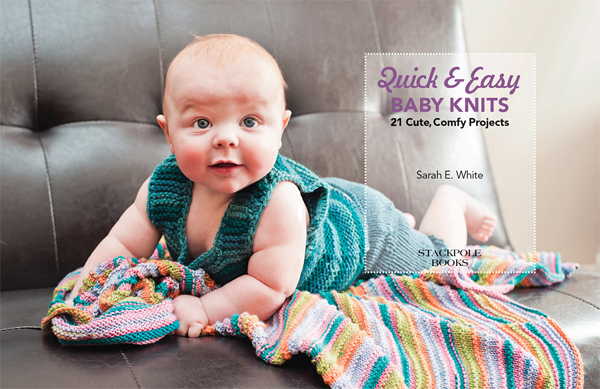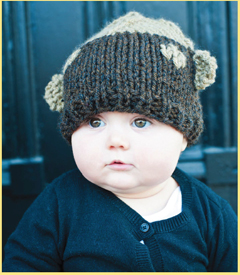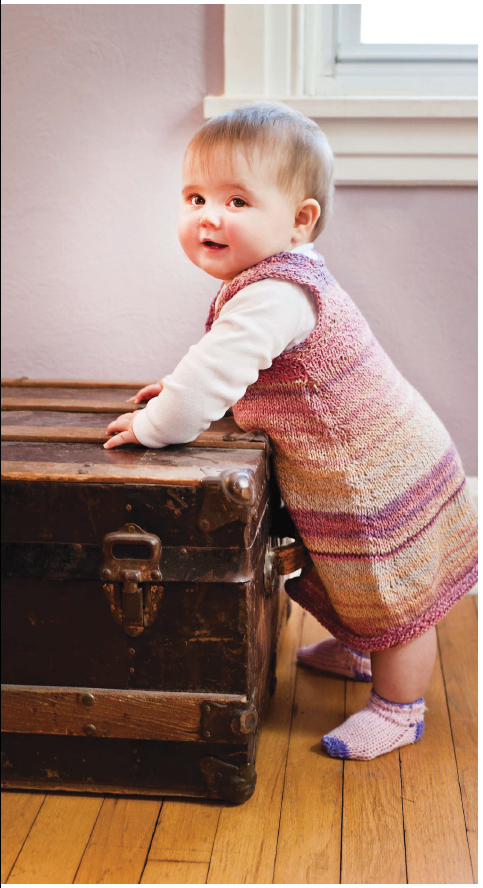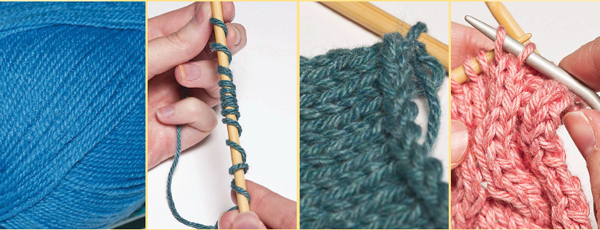INTRODUCTION
M any people start knitting, or pick up needles again after a long hiatus, because they or someone they love is about to have a baby. Knitting something for a new little one seems like such a grander symbol of love than buying a blankie from a store. Making something for someone else, baby or otherwise, takes time, skill, energy, creativity, focus, planning, and money for supplies.
When it comes to knitting for the littlest among us, youd think projects would take only a short time because babies are so small. I know I had grand ideas about the amount of knitting I could get done before my daughter was born. I imagined her wrapped in knits from head to toe, not just when she came home from the hospital, but all that first winter.
The reality is, when youre preparing for a baby, you have a lot of things to do besides knitting. In my case it also didnt help that my daughter was born six weeks early! And most knitting patterns for babies call for baby yarn, a fine-weight yarn that inherently takes a long time to knit with, because the yarn and the needles for it are so small.
Just for comparison, baby yarn is classified as either weight category 1 or 2 (more on weight categories later), which means it ranges from 23 to 32 stitches per 4 inches (10 cm) and is worked on needles from size US 1 to US 5 (2.25mm to 3.75mm). The medium-weight yarn I use in a lot of the projects in this book is classified as weight 4, has an average of 16 to 20 stitches per inch, and is worked on larger needles in the range of US 7 to US 9 (4.5mm to 5.5mm). That gives you some idea how much faster bigger yarn is to work with, if it has as few as half as many stitches per inch as a smaller yarn.
My daughter is now four and I dont worry so much about trying to knit her clothes in fine yarn. I like the look of bulkier knits, and they dont seem so delicate and precious as traditional baby knits, which is perfect for the toddler lifestyle. Its great for babies, too, because you want to knit things people will actually use and not think of as too nice to let their baby anywhere near.
Several of my mom friends got pregnant again around the same time, leaving me with a bunch of baby knitting to do all at once. (When your friends know youre a professional knitter, a store-bought gift just will not do.)
There was no way I was going to be able to knit all I wanted for those babies, particularly if I used traditional baby knitting materials; there were three baby showers in the span of about eight weeks, and two babies with due dates just a week apart. Thus the Quick & Easy method was born.
What is Quick & Easy?
My Quick & Easy methods offer a lot of different options for busy knitters who still want to make something cute for the little ones in their lives:
Using heavier-weight yarns
Holding two strands together while you knit
Using simple stitch patterns embellished with cute details like stripes, cables, and lace
Admittedly Im a pretty fast knitter, but the smaller projects in this book, like socks, I could complete in a day or two, while a sweater or top might take me a week. Even if youre not knitting several hours a day, like I was while writing this book, the vast majority of these projects will go on and off your needles pretty quickly.
Baby blankets are the main exception to that rule, but even they can be completed quicker than something knit in fine yarn.
Knitting for babies is a great joy. Every kid looks cute wrapped up in knitting, and most moms are appreciative of handmade gifts. With these tips and patterns in your repertoire, youll be able to pull off impressive, pretty, and practical projects that will make you the belle of the baby shower in no time. Well, a lot less time, anyway.
About the Book
This book aims to provide you with a wide variety of relatively quick, fun, interesting, and cute knitting projects that you can knit for babies up to one year of age. There are sweaters, hats, pants, a dress, a felted diaper bag, baby socks, and more.
I tried to include a wide range of knitting techniques to make projects more fun, and every project has a little something different, whether thats throwing a knit row on the wrong side of stockinette, adding stripes, or using a bit of colorwork, cabling, or lace.
Dont worry if youre a new knitter; basic knitting instructions are given before the patterns, and anything special you need beyond a specific pattern is described with that pattern. Nothing here is really that difficult, so I hope youll try the projects even if a technique is new to you. Theres also a resource section at the back of the book where you can learn more about all the techniques and skills used here. Lets get started, shall we?
A Note on Color Choices
For many of the patterns in this book I went with rather traditional colors: blue for boys, pink and purple for girls, and a little green thrown in on both sides. But I dont want you to feel limited by those colors or think that just because something is knit in boy colors means it needs to be a boy project.
There are only a couple of things here (the dress and the lace hat) that I wouldnt consider appropriate for both genders, so keep an open mind when you look at the samples. I offer suggestions on opposite gender and gender-neutral color options in the same yarn lines when appropriate, so you wont have to spend a lot of time thinking about how to change a patterns coloring.
As for the blankets, one is blue, one has shades of pink and purple, and the other two use multicolored yarns that are appropriate for either gender. One has pink, but also orange. The other has some purple but is predominantly blue. You be the judge, but also dont judge a pattern by its color palette; if you need a different one, feel free to change it up.
LEARNING
TO KNIT
W hether youre completely new to knitting or are coming back to the craft after a long break, dont worry. This chapter will give you all the basics you need to complete any of the projects in this book, as well as specific techniques that are only needed for a handful of patterns. If youre an old pro, feel free to skip this section and refer to it only if you have a problem.
Materials and Supplies
Before you start knitting you have to gather a few basic supplies that will allow you to make all your Quick & Easy knits. You can get started with a trip to your local craft shop or yarn store, or visit any of the excellent online retailers of knitting goods if you need something special you are unable to find elsewhere.
Yarn
Most knitters begin their love affair with the craft because of the yarn. There are many different kinds and colors of yarn to choose from, so the knitting doesnt have to be complicated for you to make a showstopper of a piece.
When knitting for babies and young children, I keep two major principles in mind: softness and durability. Durability for me includes washability, because I know new moms will be unable or unwilling to take the time to handwash garments or blankets (though, if youre knitting for yourself or a fellow knitter, feel free to break out the non-superwash wool, alpaca, cashmere, or whatever else you like).

